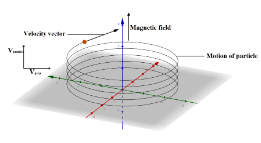
Pitch of the helical path described by the particle is:
Answer
503.4k+ views
1 likes
Hint: When a charged particle goes through a region of magnetic field, two different forces act on it. First one is the force exerted on charged particles due to the magnetic field and the other force is centripetal force. The velocity of a particle is constant in the direction parallel to the magnetic field and the motion is accelerating in the direction perpendicular to the magnetic field. We will find the expression for velocity, time period and pitch of the helical path described by the particle.
Formula used:
Magnetic force,
Centripetal force,
Complete step by step answer:
Suppose that a charged particle of mass
Also, force exerted on the moving charge under the magnetic field is given by,
A charged particle placed in a magnetic field executes a circular orbit in the plane perpendicular to the direction of the field. Since, the magnetic force on the particle

Magnetic force acting on the particle having charge
Where,
The magnetic force on a charged particle acts perpendicular to both the velocity and magnetic field.
Magnitude of magnetic force is given as,
Centripetal force on charged particle,
Where,
Since, charged particle is assumed to have a constant speed in the region parallel to the magnetic field,
Therefore, magnetic force should be equal to centripetal force
Time taken by the particle to complete one full oscillation, that is, time period of the oscillation is,
Pitch is the distance moved by the particle along the direction of magnetic field in one rotation,
Where,
Pitch of the helical path described by the particle is
Hence, the correct option is A.
Note:
Motion of charged particles is accelerating, circular motion, in the direction perpendicular to the magnetic field. But, in the direction parallel to the magnetic field, the particle moves with a constant speed because the magnetic field applies force only in the direction perpendicular to it. Thus, the force cannot do work on the particle, meaning that there is no change in its kinetic energy and therefore, the particle moves with a constant speed in the direction parallel to the magnetic field.
Formula used:
Magnetic force,
Centripetal force,
Complete step by step answer:
Suppose that a charged particle of mass
Also, force exerted on the moving charge under the magnetic field is given by,
A charged particle placed in a magnetic field executes a circular orbit in the plane perpendicular to the direction of the field. Since, the magnetic force on the particle

Magnetic force acting on the particle having charge
Where,
The magnetic force on a charged particle acts perpendicular to both the velocity and magnetic field.
Magnitude of magnetic force is given as,
Centripetal force on charged particle,
Where,
Since, charged particle is assumed to have a constant speed in the region parallel to the magnetic field,
Therefore, magnetic force should be equal to centripetal force
Time taken by the particle to complete one full oscillation, that is, time period of the oscillation is,
Pitch is the distance moved by the particle along the direction of magnetic field in one rotation,
Where,
Pitch of the helical path described by the particle is
Hence, the correct option is A.
Note:
Motion of charged particles is accelerating, circular motion, in the direction perpendicular to the magnetic field. But, in the direction parallel to the magnetic field, the particle moves with a constant speed because the magnetic field applies force only in the direction perpendicular to it. Thus, the force cannot do work on the particle, meaning that there is no change in its kinetic energy and therefore, the particle moves with a constant speed in the direction parallel to the magnetic field.
Latest Vedantu courses for you
Grade 11 Science PCM | CBSE | SCHOOL | English
CBSE (2025-26)
School Full course for CBSE students
₹41,848 per year
Recently Updated Pages
Express the following as a fraction and simplify a class 7 maths CBSE

The length and width of a rectangle are in ratio of class 7 maths CBSE

The ratio of the income to the expenditure of a family class 7 maths CBSE

How do you write 025 million in scientific notatio class 7 maths CBSE

How do you convert 295 meters per second to kilometers class 7 maths CBSE

Write the following in Roman numerals 25819 class 7 maths CBSE

Trending doubts
Give 10 examples of unisexual and bisexual flowers

Draw a labelled sketch of the human eye class 12 physics CBSE

Differentiate between homogeneous and heterogeneous class 12 chemistry CBSE

Differentiate between insitu conservation and exsitu class 12 biology CBSE

What are the major means of transport Explain each class 12 social science CBSE

Franz thinks Will they make them sing in German even class 12 english CBSE




